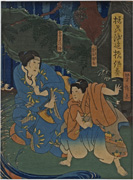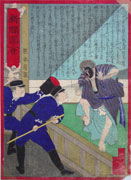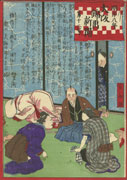Prints in Collection
IHL Cat. #1839
IHL Cat. #1963
Momo Chidori Naruto no Shiranami,
May 1875
IHL Cat. #614
Biographical Data
Biography
Utagawa Yoshitaki 歌川芳滝 (1841-1899)
Sources: A Dictionary of Japanese Artists: Painting, Sculpture, Ceramics, Prints, Lacquer, Laurance P. Roberts, Weatherhill, 1976, p. 203, William Wetherall's News Nishiki website; The Hotei Encyclopedia of Japanese Woodblock Prints, Amy Reigle Newland, Hotei Publishing Company, 2005, p. 445; The Theatrical World of Osaka Prints, Roger S. Keyes and Keiko Mizushima, David R. Godine in association with Philadelphia Museum of Art, 1973, p.255; "A Look at Some Original Paintings by Yoshitaki: Development From the Late Edo Period to the Meiji Period," Yamamoto Sumiko, an online article in Aesthetics No. 13, 2009, Kamigata Ukiyoe Museum, Osaka
In addition to creating woodblock prints of actors and of landscapes1, Yoshitaki, using the artist names Sasaki Yoshitaki 笹木芳瀧 (starting in 1875) and Nakai Yoshitaki 中井芳瀧, created (wrote and illustrated) specialized woodblock prints called nishki-e shinbun for several Osaka newspapers including the Osaka nishikiga shinbun, Osaka nishikie shinwa, Kanzen choaku nishikiga shinbun, and Shinbun zue. (See related article Nishiki-e shinbun and Newspapers in Meiji Japan.) Yoshitaki also remained active as a painter, exhibiting both in Japan and internationally, winning bronze medals at the first two Naikoku Kaiga Kyoshin Kai (National Paintings Fair) in 1882 and 1884 and a meritorious mention at the fourth Naikoku Kangyo Hakurankai (National Expo for the Promotion of Industry.) As with many woodblock artists he also worked as a commerical artist, creating theater billboards and illustrations for a sake company.
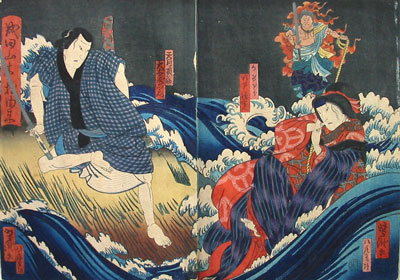 Naritasan ki fuda no yurai, Yoshitaki, 1871 chuban diptych | Yoshitaki was born Nakai Tsunejirō (Kōjirō) 中井恒次郎 in Shimizucho in Osaka in 1841 as the eldest son of Nakai Genbei 中井源兵衛, a paste merchant. From age 12 to 15, Yoshitaki was a student of Nakajima Yoshiume 中島芳梅 (1819-1879), who had studied under Utagawa Kuniyoshi (1797-1861). His earliest prints were published when he had barely entered his teens. In 1855 he left Yoshiume to be an independent artist. For a period of twenty years, Yoshitaki was the most prolific of Osaka print artists, producing more than 1,200 designs, nearly all yakusha-e (actor pictures.) In 1880, he moved to Kyoto and in 1885 he moved to Sakai where he died in 1889. He is buried at Nanshuji on Ryukozan in Sakai. |
His own students included Goto Yoshikage (1894-1892), Kawasaki Kyosen (1877-1942), and Sasaki Yotsimitsu (his younger brother). The artist’s son-in-law, Kawasaki Kyosen, wrote an article on his father’s practice as a designer of actor prints in Osaka titled How Color Prints are Made that provides a first hand account of the production of actor prints in Osaka during the early Meiji period.
1 e.g., Naniwa Hyakukei (One Hundred Views of Osaka), co-produced with Utagawa Kunikazu (fl. C. 1848-1868) and Nansui Yoshiyuki (1835-1879)
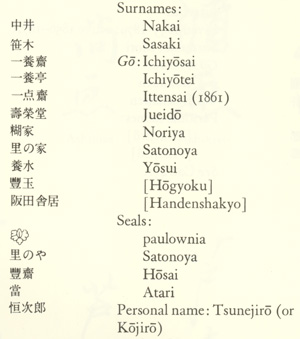 The Theatrical World of Osaka Prints, Roger S. Keyes and
The Theatrical World of Osaka Prints, Roger S. Keyes and
Keiko Mizushima, David R. Godine in association with
Philadelphia Museum of Art, 1973, p. 279.
1 e.g., Naniwa Hyakukei (One Hundred Views of Osaka), co-produced with Utagawa Kunikazu (fl. C. 1848-1868) and Nansui Yoshiyuki (1835-1879)
Other Names and Seals

Keiko Mizushima, David R. Godine in association with
Philadelphia Museum of Art, 1973, p. 279.
Signatures
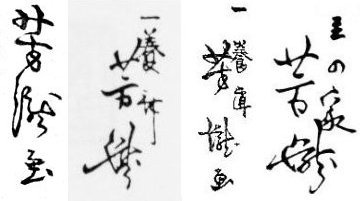 left to right: “Yoshitaki ga” (芳滝 画), “Ichiyōsai Yoshitaki” (一養斎 芳滝), “Ichiyōtei Yoshitaki ga” (一養亭 芳滝 画), and “Satonoya Yoshitaki” (里の家 芳滝) (wikipedia) |  Sasaki Yoshitaki 笹木芳瀧 |
